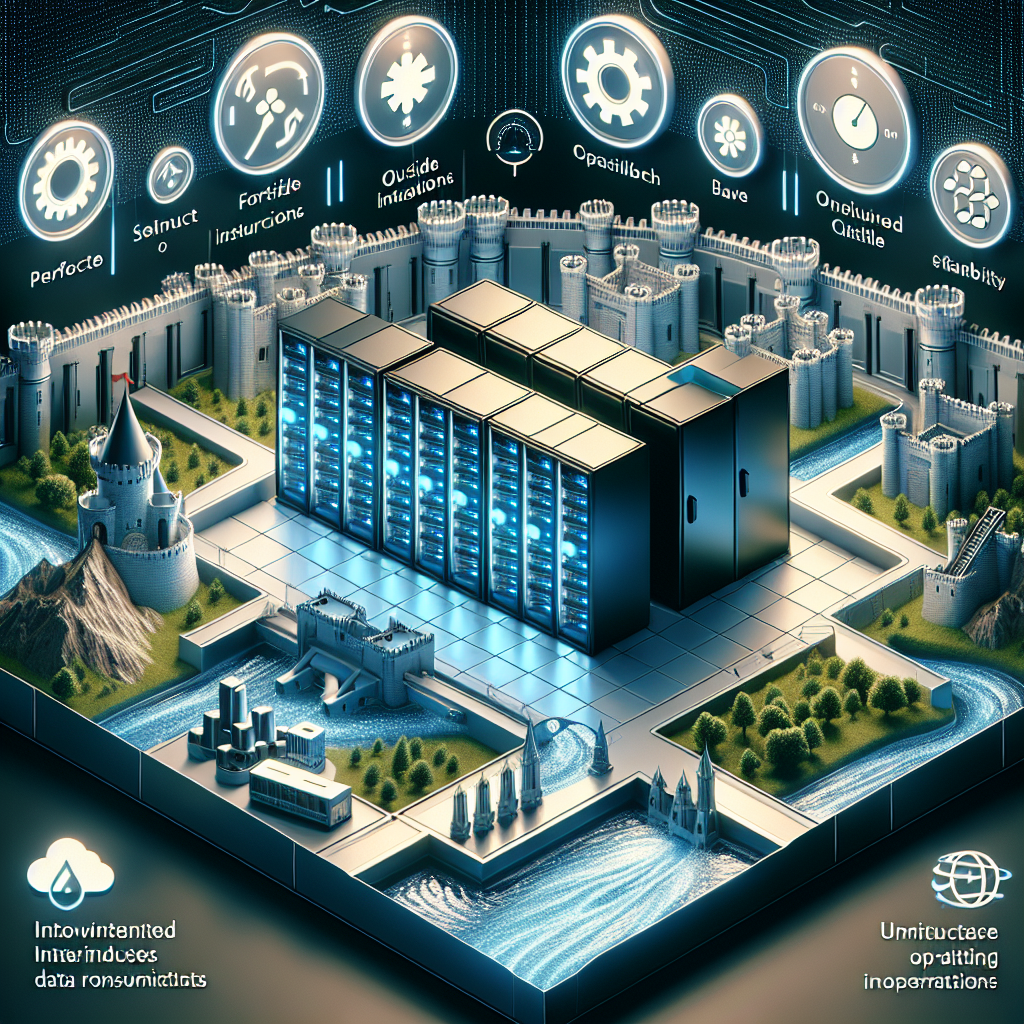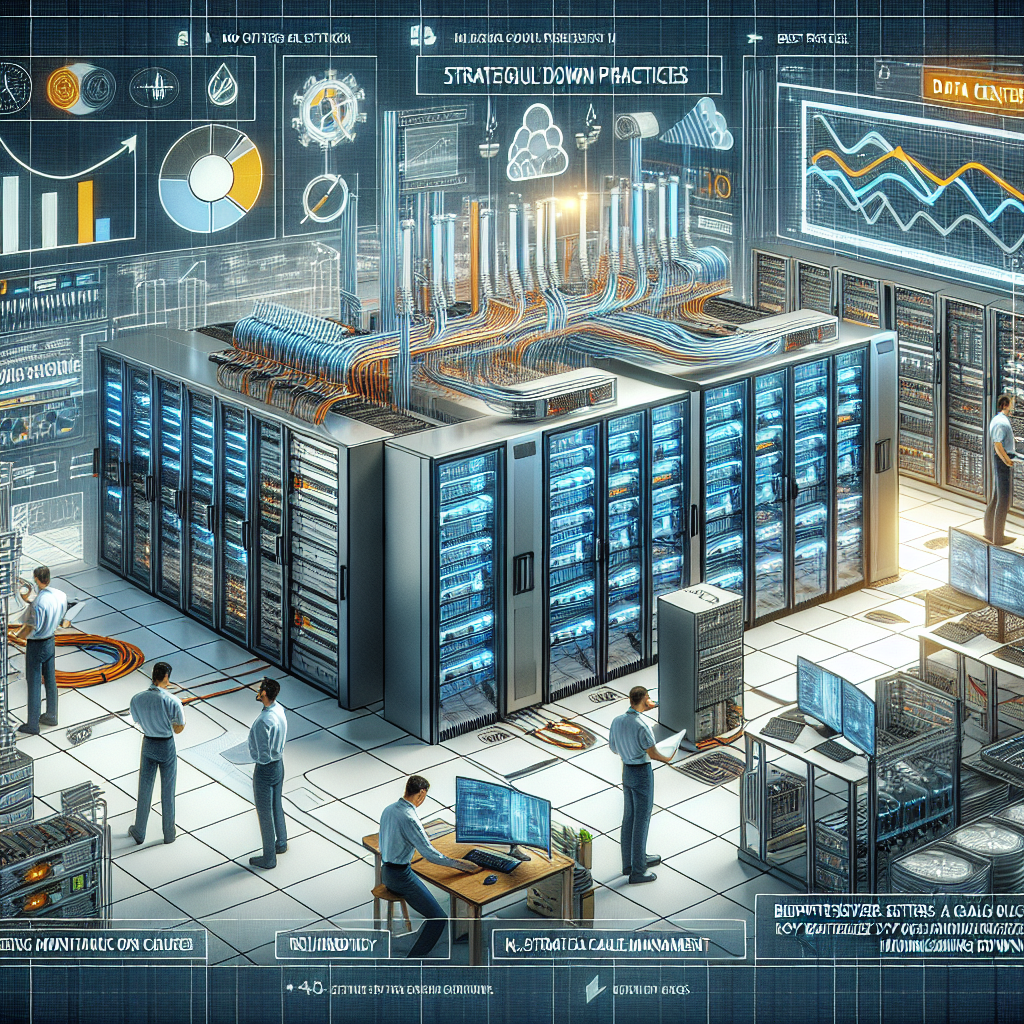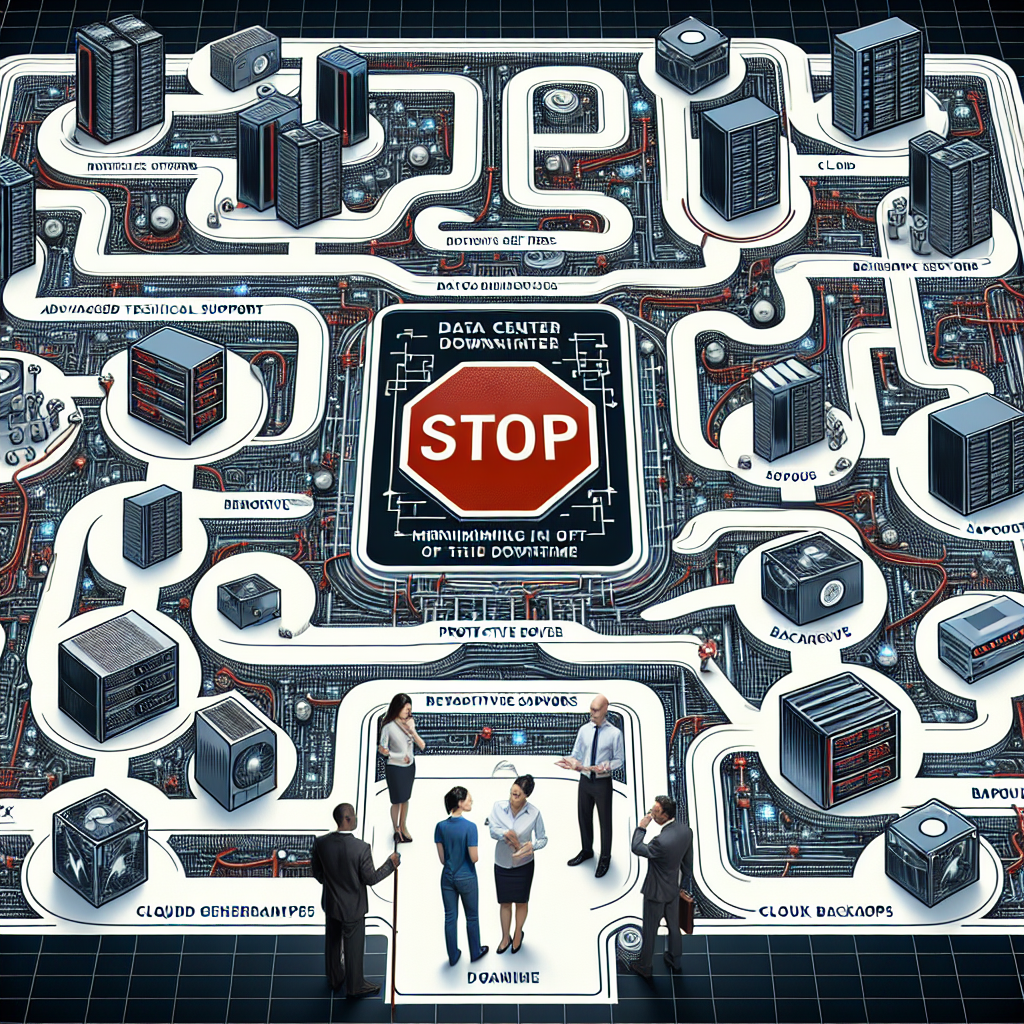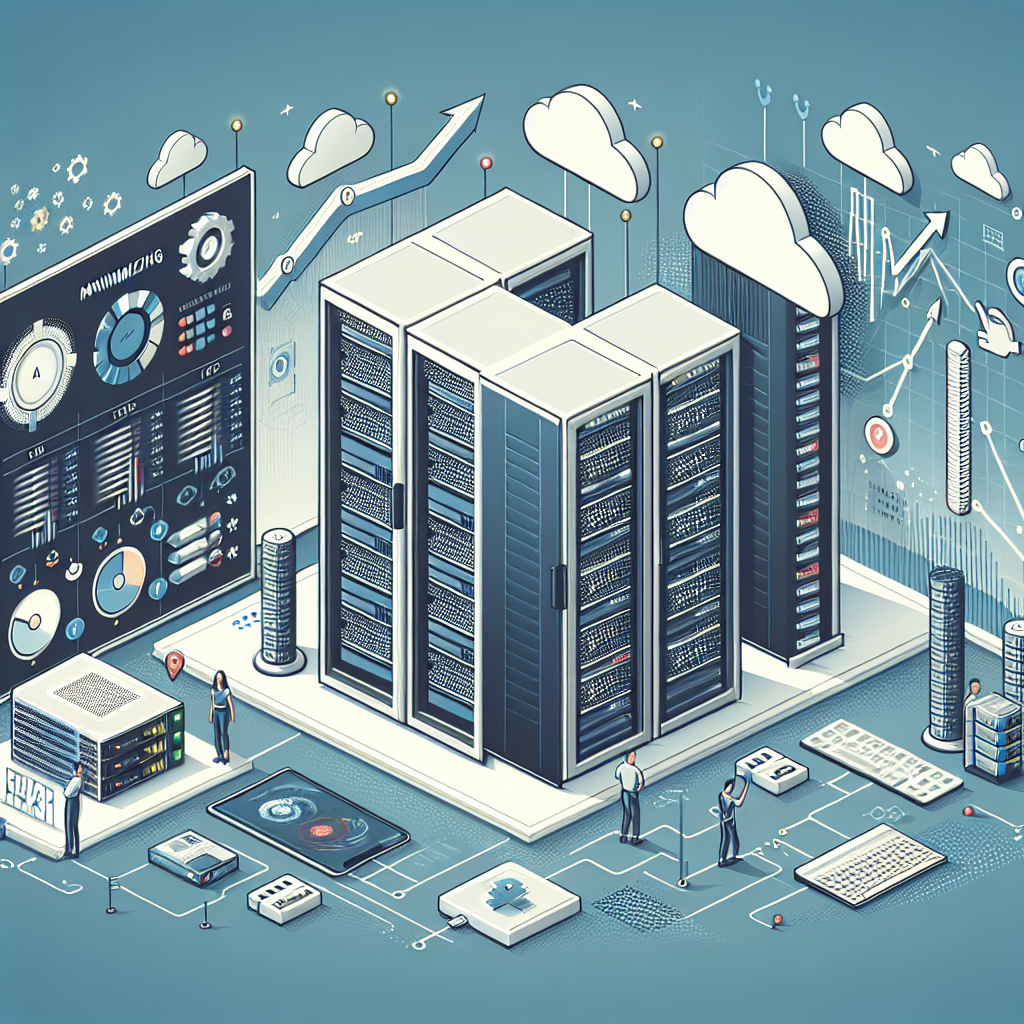Your cart is currently empty!
Tag: Minimizing

Achieving 100% Data Center Uptime: Strategies for Minimizing Disruptions
In today’s digital age, data centers are the backbone of many businesses, providing the necessary infrastructure for storing and processing critical data. With the increasing reliance on data centers, ensuring maximum uptime is crucial to prevent disruptions that can have costly consequences. Achieving 100% data center uptime may seem like a lofty goal, but with the right strategies in place, it is possible to minimize disruptions and keep operations running smoothly.One of the key strategies for achieving 100% data center uptime is implementing a robust monitoring system. Monitoring the performance of servers, networks, and other critical components in real-time can help identify potential issues before they escalate into full-blown outages. By proactively monitoring key metrics such as temperature, power consumption, and network traffic, data center operators can quickly respond to anomalies and take corrective action to prevent downtime.
Another important strategy for minimizing disruptions is implementing a comprehensive backup and disaster recovery plan. In the event of a hardware failure, natural disaster, or cyber attack, having a backup plan in place can help quickly restore operations and minimize downtime. Regularly testing and updating backup systems is essential to ensure they are ready to spring into action when needed.
Proper maintenance and upkeep of data center equipment is also critical for achieving 100% uptime. Regularly scheduled maintenance, including cleaning, testing, and upgrading components, can help prevent unexpected failures and prolong the lifespan of critical infrastructure. Investing in high-quality equipment and working with reliable vendors can also help reduce the risk of downtime due to faulty hardware.
Redundancy is another key strategy for minimizing disruptions in the data center. By implementing redundancy in critical systems such as power supplies, cooling systems, and network connections, data center operators can ensure that operations can continue uninterrupted even in the event of a single point of failure. Redundant systems provide a safety net that can help prevent downtime and keep operations running smoothly.
Finally, having a skilled and knowledgeable team of IT professionals is essential for achieving 100% data center uptime. With the rapid pace of technology advancements, it is important to invest in ongoing training and development for data center staff to keep them up-to-date on the latest trends and best practices. A well-trained team can quickly troubleshoot issues, implement solutions, and prevent disruptions before they impact operations.
In conclusion, achieving 100% data center uptime is a challenging but attainable goal with the right strategies in place. By implementing a robust monitoring system, backup and disaster recovery plan, regular maintenance, redundancy, and a skilled team of IT professionals, data center operators can minimize disruptions and keep operations running smoothly. Investing in these strategies can help ensure that data centers remain reliable, resilient, and ready to meet the demands of today’s digital economy.

The Importance of Data Center Redundancy: Ensuring High Availability and Minimizing Downtime
In today’s digital age, data centers play a crucial role in the smooth operation of businesses and organizations. These facilities house the servers, storage devices, networking equipment, and other critical components that store and manage vast amounts of data. With the increasing reliance on data for day-to-day operations, ensuring high availability and minimizing downtime in data centers has become essential.One key factor that contributes to the high availability of data centers is redundancy. Redundancy refers to having backup systems and components in place to ensure that if one component fails, another can seamlessly take over. This redundancy is critical in preventing downtime and ensuring that data and services remain accessible to users at all times.
There are several areas in a data center where redundancy is crucial. One of the most important is power redundancy. Data centers require a constant and reliable power supply to keep their equipment running. Power outages can be disastrous for data centers, leading to data loss and downtime. To mitigate this risk, data centers often have multiple power sources, backup generators, and uninterruptible power supply (UPS) systems in place to ensure continuous power availability.
Another critical area where redundancy is essential is in networking. Data centers rely on a complex network infrastructure to connect servers and devices and facilitate data transfer. Network failures can severely impact the availability of services and data. By implementing redundant networking components, such as multiple switches, routers, and network paths, data centers can ensure that network connectivity is maintained even if one component fails.
Storage redundancy is also crucial for data centers. Storage systems store and manage the data that organizations rely on for their operations. By implementing redundant storage systems, such as RAID configurations and backup solutions, data centers can protect against data loss and ensure that data remains accessible even in the event of a storage system failure.
In addition to hardware redundancy, data centers also implement redundancy at the facility level. This includes redundant cooling systems, fire suppression systems, and physical security measures to ensure that the data center can continue operating even in the face of environmental or security threats.
Overall, data center redundancy is crucial for ensuring high availability and minimizing downtime. By implementing redundant systems and components, data centers can protect against a wide range of potential failures and ensure that data and services remain accessible to users at all times. Investing in redundancy is a key strategy for organizations looking to maintain the reliability and uptime of their data center operations.

Minimizing Downtime Risks: Strategies for Maintaining Data Center Uptime
In today’s digital age, data centers play a crucial role in the smooth functioning of businesses. Any downtime in a data center can lead to significant financial losses and tarnish an organization’s reputation. Therefore, it is essential for organizations to implement strategies to minimize downtime risks and ensure data center uptime.One of the key strategies for maintaining data center uptime is regular maintenance and monitoring. By conducting routine maintenance checks on hardware, software, and infrastructure components, potential issues can be identified and addressed before they escalate into full-blown problems. Monitoring systems can also help detect abnormalities and alert IT staff to potential issues that could lead to downtime.
Another crucial aspect of minimizing downtime risks is having a robust backup and disaster recovery plan in place. In the event of a hardware failure, natural disaster, or cyber-attack, having a backup plan ensures that data can be quickly restored and business operations can resume without significant interruptions. Regularly testing these backup systems is also essential to ensure they are functioning properly and can be relied upon when needed.
Furthermore, implementing redundancy in critical systems and components can help mitigate downtime risks. By having duplicate systems in place, organizations can ensure that operations can continue even if one system fails. Redundancy can be applied to power sources, network connections, and cooling systems to minimize the impact of potential failures.
Proactive monitoring and predictive analytics can also help organizations identify potential issues before they lead to downtime. By analyzing data trends and patterns, IT teams can anticipate problems and take preventive measures to avoid disruptions. Implementing automation tools can also help streamline operations and reduce the risk of human error, which can lead to downtime.
In conclusion, minimizing downtime risks is essential for maintaining data center uptime and ensuring business continuity. By implementing strategies such as regular maintenance, backup and disaster recovery plans, redundancy, and proactive monitoring, organizations can reduce the likelihood of downtime and protect their critical data and operations. Investing in these strategies can ultimately save organizations time, money, and reputation in the long run.

Mitigating the Effects of Data Center Downtime: Strategies for Minimizing Disruption
Data center downtime can be a costly and disruptive event for any organization. It can result in lost revenue, damage to reputation, and a significant impact on productivity. In order to mitigate the effects of data center downtime, it is important for organizations to have strategies in place to minimize disruption and ensure business continuity.One of the key strategies for mitigating the effects of data center downtime is to have a comprehensive disaster recovery plan in place. This plan should outline the steps that need to be taken in the event of a data center outage, including how data will be backed up and restored, how systems will be brought back online, and how communication will be maintained with stakeholders and customers.
Another important strategy for minimizing disruption during data center downtime is to regularly test and update backup systems and procedures. This includes testing data backups to ensure they are functioning correctly, as well as updating software and hardware to ensure they are compatible with the latest technology and security standards.
It is also important for organizations to have redundant systems in place to minimize the impact of data center downtime. This can include redundant power supplies, servers, and network connections, as well as geographically dispersed data centers to ensure data can be accessed in the event of a regional outage.
In addition, organizations should have a clear communication plan in place to keep stakeholders informed during a data center outage. This can include notifying customers of any disruptions to services, as well as providing regular updates on the status of the data center and when services are expected to be restored.
Overall, mitigating the effects of data center downtime requires a proactive approach that includes comprehensive disaster recovery planning, regular testing and updating of backup systems, redundant systems, and clear communication with stakeholders. By implementing these strategies, organizations can minimize disruption and ensure business continuity in the event of a data center outage.

Strategies for Improving Data Center MTTR and Minimizing Downtime
Data centers play a crucial role in today’s digital world, serving as the backbone for storing and processing vast amounts of data. However, downtime in data centers can have significant consequences, leading to lost revenue, damaged reputation, and decreased productivity. In order to minimize downtime and improve Mean Time to Recovery (MTTR), data center operators must implement effective strategies to address potential issues proactively.One key strategy for improving data center MTTR and minimizing downtime is to invest in redundancy and failover systems. Redundancy ensures that critical systems have backup components in place, allowing for seamless operation in the event of a failure. This can include redundant power supplies, network connections, and cooling systems. Failover systems automatically switch to a backup system when the primary system fails, reducing downtime and improving overall system reliability.
Regular maintenance and monitoring are also essential for minimizing downtime in data centers. By conducting routine inspections and preventative maintenance, operators can identify and address potential issues before they escalate into major problems. Monitoring tools can provide real-time visibility into the performance of critical systems, allowing operators to identify and resolve issues quickly. Additionally, implementing predictive maintenance techniques, such as using data analytics to predict when equipment is likely to fail, can help prevent downtime before it occurs.
Another strategy for improving data center MTTR is to establish clear incident response procedures. By creating a detailed plan for how to respond to different types of incidents, operators can ensure a swift and coordinated response when downtime occurs. This can include identifying key personnel responsible for responding to incidents, establishing communication protocols, and outlining steps for troubleshooting and resolving issues. Regularly testing and updating incident response procedures can help ensure that operators are prepared to respond effectively in the event of downtime.
In addition to these strategies, data center operators can also leverage automation and artificial intelligence (AI) to improve MTTR and minimize downtime. Automation tools can streamline routine tasks and processes, reducing the risk of human error and speeding up response times. AI-powered analytics can also help identify patterns and anomalies in data center operations, allowing operators to proactively address potential issues before they impact system performance.
By implementing these strategies, data center operators can improve MTTR, minimize downtime, and ensure the continued reliability and availability of critical systems. Investing in redundancy, regular maintenance, incident response procedures, and automation can help data centers operate more efficiently and effectively, reducing the risk of costly downtime and maximizing uptime for businesses and organizations.

Maximizing Uptime: Strategies for Minimizing Data Center MTTR
In today’s digital age, data centers play a crucial role in ensuring the smooth operation of businesses and organizations. These facilities house servers, storage devices, networking equipment, and other critical infrastructure that support the delivery of services and applications.However, data centers are not immune to downtime, which can have a significant impact on business operations. Mean Time to Repair (MTTR) is a key metric that measures the average time it takes to restore service after an outage. Minimizing MTTR is essential for maximizing uptime and ensuring the reliability of data center operations.
There are several strategies that data center operators can employ to minimize MTTR and maximize uptime. These include:
1. Implementing proactive maintenance: Regular maintenance and monitoring can help identify potential issues before they cause downtime. By conducting routine inspections, equipment testing, and performance monitoring, data center operators can address issues proactively and prevent them from escalating into larger problems.
2. Investing in redundancy: Redundancy is a critical component of a resilient data center infrastructure. By implementing redundant power supplies, cooling systems, networking equipment, and storage devices, data center operators can ensure that there are backup systems in place to minimize downtime in the event of a failure.
3. Automating processes: Automation can help streamline data center operations and reduce the risk of human error. By automating routine tasks such as system updates, backups, and failover procedures, data center operators can respond more quickly to incidents and minimize MTTR.
4. Implementing a comprehensive monitoring and alerting system: Monitoring tools can provide real-time visibility into the performance and health of data center infrastructure. By setting up alerts for potential issues, data center operators can proactively address problems before they impact service availability.
5. Establishing clear incident response procedures: Having well-defined incident response procedures in place can help data center operators quickly identify the cause of an outage and take appropriate actions to restore service. By conducting regular drills and training exercises, data center staff can improve their response times and minimize MTTR.
By implementing these strategies, data center operators can minimize MTTR and maximize uptime, ensuring the reliability of their operations and the continuity of business services. Investing in proactive maintenance, redundancy, automation, monitoring tools, and incident response procedures can help data centers achieve high levels of availability and performance.

The Importance of Disaster Recovery Planning in Minimizing Data Center Downtime
In today’s digital age, data centers play a crucial role in the operations of businesses across various industries. These facilities house important data and applications that are essential for day-to-day operations. However, data centers are also susceptible to various risks, such as natural disasters, cyberattacks, and equipment failures. When these risks materialize, they can lead to significant downtime and data loss, resulting in financial losses and damage to a company’s reputation.This is where disaster recovery planning comes into play. Disaster recovery planning involves creating a comprehensive strategy to ensure that data center operations can quickly resume in the event of a disaster. This includes backing up data, implementing redundant systems, and establishing protocols for responding to emergencies.
One of the key benefits of disaster recovery planning is its ability to minimize data center downtime. Downtime can be extremely costly for businesses, as it can disrupt operations, lead to lost revenue, and damage customer relationships. By having a solid disaster recovery plan in place, businesses can minimize the impact of downtime and ensure that critical systems are up and running as quickly as possible.
Additionally, disaster recovery planning can help businesses comply with regulatory requirements. Many industries have strict regulations regarding data protection and business continuity. By implementing a disaster recovery plan, businesses can demonstrate to regulators that they are taking the necessary steps to protect their data and maintain business continuity.
Furthermore, disaster recovery planning can also help businesses mitigate the risk of data loss. In the event of a disaster, having backups of data can help businesses recover lost information and prevent permanent data loss. This can be crucial for businesses that rely heavily on data for their operations.
In conclusion, disaster recovery planning is essential for minimizing data center downtime and ensuring business continuity. By implementing a comprehensive disaster recovery plan, businesses can protect their data, reduce the impact of downtime, and comply with regulatory requirements. Investing in disaster recovery planning is a proactive measure that can help businesses mitigate risks and safeguard their operations in the event of a disaster.

Data Center Safety: Strategies for Minimizing Downtime and Maximizing Operational Efficiency
Data centers are the backbone of modern businesses, housing critical IT infrastructure and data that is essential for day-to-day operations. With the increasing reliance on technology, the need for data centers to be safe, secure, and efficient has never been more important. In this article, we will discuss strategies for minimizing downtime and maximizing operational efficiency in data centers to ensure business continuity.One of the key aspects of data center safety is physical security. Data centers house valuable equipment and sensitive data, making them a prime target for theft and sabotage. Implementing robust security measures such as access control systems, surveillance cameras, and security guards can help prevent unauthorized access and protect the integrity of the data center.
In addition to physical security, data centers also need to be protected from environmental threats such as fire, flooding, and power outages. Implementing fire suppression systems, water detection sensors, and uninterruptible power supply (UPS) units can help mitigate these risks and ensure that the data center remains operational in the event of an emergency.
Regular maintenance and monitoring of equipment is also crucial for data center safety. By conducting routine inspections, performing preventive maintenance, and monitoring key performance indicators, data center operators can identify potential issues before they escalate into major problems that could result in downtime.
Another important aspect of data center safety is ensuring proper cooling and ventilation. Data centers generate a significant amount of heat, and inadequate cooling can lead to equipment failure and downtime. By implementing efficient cooling systems, optimizing airflow, and monitoring temperature levels, data center operators can prevent overheating and maintain optimal operating conditions.
Maximizing operational efficiency is another key goal for data center operators. By streamlining processes, optimizing resource allocation, and implementing automation tools, data centers can operate more efficiently and effectively. This can help reduce energy consumption, improve performance, and lower operating costs.
In conclusion, data center safety is essential for ensuring business continuity and protecting valuable assets. By implementing robust security measures, protecting against environmental threats, conducting regular maintenance, and maximizing operational efficiency, data center operators can minimize downtime and maximize operational efficiency. By prioritizing safety and efficiency, data centers can continue to support the growing demands of modern businesses and ensure the smooth operation of critical IT infrastructure.

Maximizing Efficiency and Minimizing Downtime: The Role of Data Center Cabling
In today’s fast-paced digital world, data centers play a crucial role in storing, processing, and transmitting vast amounts of data. As the demand for data continues to grow, data centers must constantly adapt and evolve to keep up with the increasing workload. One important aspect of data center efficiency is the cabling infrastructure that connects servers, storage devices, and networking equipment.Maximizing efficiency and minimizing downtime in a data center environment requires a well-planned and properly installed cabling system. Data center cabling is the backbone of the entire infrastructure, providing the necessary connections for data to flow smoothly and quickly between devices. A poorly designed or outdated cabling system can lead to inefficiencies, bottlenecks, and downtime, all of which can have a significant impact on the overall performance of the data center.
There are several key factors to consider when designing and implementing a data center cabling system to maximize efficiency and minimize downtime. First and foremost, it is essential to use high-quality cabling components that are designed to handle the high bandwidth and data speeds required in a data center environment. This includes using fiber optic cables for long-distance connections and high-speed data transmission, as well as copper cables for shorter distances and lower-speed connections.
In addition to using high-quality cabling components, it is also important to properly plan and organize the cabling infrastructure within the data center. This includes implementing structured cabling systems that follow industry best practices and standards, such as TIA/EIA and ISO/IEC. By organizing cables in a neat and orderly manner, data center technicians can easily identify and troubleshoot any issues that may arise, reducing downtime and increasing overall efficiency.
Furthermore, regular maintenance and monitoring of the cabling infrastructure are essential to ensuring optimal performance and reliability. This includes conducting routine inspections to check for any signs of wear or damage, as well as testing cables for signal integrity and performance. By proactively identifying and addressing potential issues, data center operators can prevent downtime and ensure that the cabling system continues to operate at peak efficiency.
In conclusion, maximizing efficiency and minimizing downtime in a data center environment requires a well-designed and properly installed cabling infrastructure. By using high-quality components, following best practices and standards, and conducting regular maintenance and monitoring, data center operators can ensure that their cabling system is capable of handling the demands of modern data center operations. With a reliable and efficient cabling system in place, data centers can operate at peak performance, delivering the high-speed data transmission and processing capabilities that are essential in today’s digital world.

Maximizing Efficiency and Minimizing Costs: A Guide to Data Center Lifecycle Management
In today’s rapidly evolving digital landscape, data centers play a crucial role in enabling businesses to store, manage, and process large volumes of data. As data continues to grow at an exponential rate, it is more important than ever for organizations to maximize efficiency and minimize costs in their data center operations. This is where data center lifecycle management comes into play.Data center lifecycle management is a strategic approach to managing the entire lifecycle of a data center, from planning and design to operation and decommissioning. By implementing best practices and leveraging innovative technologies, organizations can optimize their data center operations to achieve cost savings, improve performance, and ensure business continuity.
Here are some key strategies for maximizing efficiency and minimizing costs in data center lifecycle management:
1. Strategic Planning: The first step in optimizing data center operations is to develop a comprehensive strategic plan that aligns with the organization’s business goals and objectives. This includes conducting a thorough assessment of current data center infrastructure, identifying areas for improvement, and establishing clear performance metrics.
2. Efficient Design: When designing a data center, organizations should prioritize energy efficiency, scalability, and flexibility. By incorporating best practices such as hot/cold aisle containment, efficient cooling systems, and modular design principles, organizations can reduce energy consumption and operational costs while ensuring the data center can easily adapt to changing business requirements.
3. Performance Monitoring: Regular monitoring and analysis of key performance indicators (KPIs) such as power usage effectiveness (PUE), server utilization, and cooling efficiency are essential for identifying opportunities to optimize data center performance and reduce costs. Real-time monitoring tools can provide valuable insights into the health and efficiency of the data center infrastructure.
4. Automation and Orchestration: Automation and orchestration technologies can streamline data center operations, improve resource utilization, and reduce human error. By automating routine tasks such as server provisioning, workload balancing, and system maintenance, organizations can free up IT staff to focus on more strategic initiatives while reducing operational costs.
5. Capacity Planning: Effective capacity planning is critical for ensuring that data center resources are utilized efficiently and cost-effectively. By forecasting future demand, organizations can proactively allocate resources, optimize server utilization, and avoid costly over-provisioning.
6. Decommissioning and Recycling: As data center hardware reaches the end of its lifecycle, organizations should have a plan in place for decommissioning and recycling outdated equipment. Proper disposal and recycling of old hardware not only reduces environmental impact but also helps organizations recover valuable materials and reduce disposal costs.
By implementing these strategies and best practices, organizations can maximize efficiency and minimize costs in their data center operations. Data center lifecycle management is an ongoing process that requires continuous monitoring, optimization, and innovation to stay ahead of the curve in today’s fast-paced digital economy. By taking a strategic approach to managing the entire lifecycle of their data centers, organizations can achieve significant cost savings, improve performance, and drive business success.
